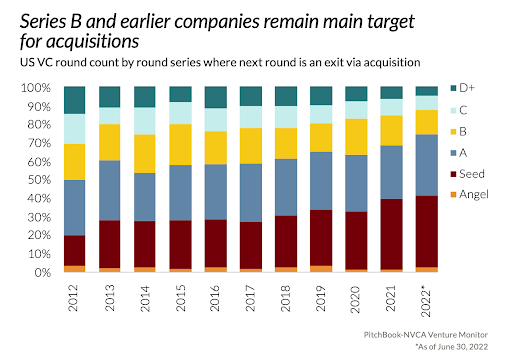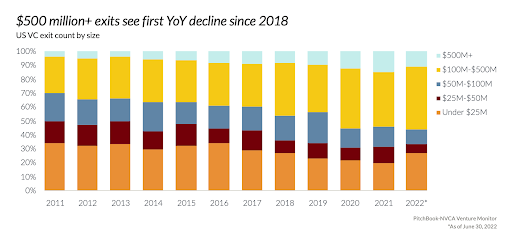The Art of Exit
Often times founders become engrossed in the art of fundraising, but the truly toughest challenge to most is, in fact, the art of the exit.

Companies are bought not sold. But that doesn't mean you should sit around waiting for gifts to happen. Against the current challenging backdrop, when exits get tougher, founders, now more than ever, need to think ahead about where they want to take their business. Financing options are not going to be as abundant, and adding exits into your options pathway makes a lot of sense.
The first thing to recognise is that, in the US, just under 90% of exits happen at Series B or below, with around 90% of the valuations being $500m or below.

In fact, around half of exits are between $100-$500m, with 30% valued at $25m or below. During the 2020 and 2021 hype market, these numbers were slightly lower, with 15% of exits being above $500m. But, in essence, these numbers have not changed for over a decade.

Are all these founders selling out too early, or can we derive some wisdom from these exits? Here’s why a founder, when looking to hit their next milestone, might skip the next round in favour of alternatives.
- The first reason is simply that the best available route to scale is consolidation – partnering with another player in the market to create size and better market dynamics, with improved margins and lower costs. Mergers have generated incredible value in tech, allowing founders to build a shared vision rather than fighting their competitors head-to-head. This is particularly true for marketplaces including examples like the combination of Zillow and Trulia, and the various mergers that happened in the food delivery and mobility space. Not all are headline mergers but they drove a lot of value. It remains one of the most underrated ways of creating scale and new value in tech.
- Second, partnering with a company that is two or three times as big, in addition to being public, gives you greater scale and access to larger public markets for financing. Facebook’s acquisition of WhatsApp and Instagram and Google’s acquisition of Android are great examples of that.
- And third, for those companies usually valued at above $500m going for an IPO allows you to expand beyond private capital, tapping into the public markets to continue growth. That’s the optionality that being a public company provides: you have the potential for a much broader set of capital if managed correctly.
Start to prepare 12-24 months ahead of a sale
When you begin evaluating your future exit event, there is a lot to prepare. These are all things you should be pursuing in the ordinary course of business. As always, the team comes first and understanding how they will react to a sale is essential. At the end of the day, they are a critical asset and you need them onboard and incentivized whether or not they will become part of the acquisition. You also need to identify where your weaknesses are and shore them up by strengthening the team, tech, business model or strategy to ensure you come across as strong as possible.
There is also a lot to get organised. You need to ensure you have all your contracts, corporate records, capitalisation tables, IP rights, and data privacy in order plus provide multiple years of audited accounts. Avoid the stress of patching over weaknesses at the last minute by creating good record-keeping habits from get-go. Finally, you need to decide on whether you need different advisors from financial advisors to tax accountants or other speciality consultants. All of this takes a lot of time, energy and money. Starting to prepare all of this 12-24 months ahead of a sale could be invaluable and gives you options when potentially you need it the most.
Founders forget that selling a business is a strategy in itself and can take a lot of time. Thinking ahead and turning a sale as one of the options can provide you with a unique opportunity to take your business to a whole new level entirely.

